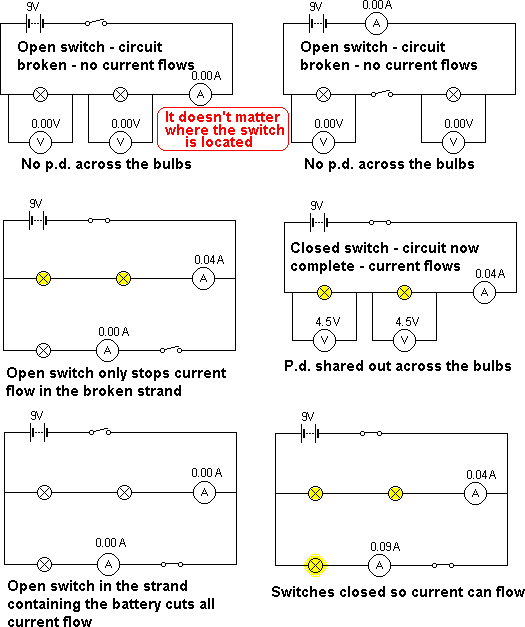Basic electricity - Simple circuits
Summary of Basic
Circuit Knowledge
 ammeter
ammeter
 cells in series
cells in series
 characteristic curves
characteristic curves
 circuit symbols
circuit symbols
 current
current
 diode
diode
 equations
equations
 Kirchhoff's First Law
Kirchhoff's First Law
 ohmmeter
ohmmeter
 Ohm's Law
Ohm's Law
 parallel circuits
parallel circuits
 potential difference
potential difference
 power
power
 resistances in parallel
resistances in parallel
 resistances in series
resistances in series
 series circuits
series circuits
 voltmeter
voltmeter
When an electric current flows through
a circuit, energy is transferred from the battery or power supply
to the components in the electrical circuit.
An electric current is a flow
of charge.
A
current will flow through an
electrical component (or device) only if:
 there is a voltage or potential
difference (p.d.) across its ends. The bigger the potential difference
across a component, the bigger the current that flows through it.
there is a voltage or potential
difference (p.d.) across its ends. The bigger the potential difference
across a component, the bigger the current that flows through it.
 It is part of a complete circuit. If there is a gap in the circuit then the whole strand that the gap is in will not have current flow through it.
It is part of a complete circuit. If there is a gap in the circuit then the whole strand that the gap is in will not have current flow through it.

Measuring Instuments
 The
p.d. across a component in a circuit is measured in volts (V) using
a voltmeter
The
p.d. across a component in a circuit is measured in volts (V) using
a voltmeter connected across
(in parallel with) the component.
connected across
(in parallel with) the component.
 The current flowing through
a component in a circuit is measured in amperes (A) using an ammeter
The current flowing through
a component in a circuit is measured in amperes (A) using an ammeter connected
in series with the component.
connected
in series with the component.
 An ohmmeter measures the resistance of a component in ohms (Ω). The component should not be in a circuit when measured - or if it is fixed within a circuit you need to make sure there is no power applied to that circuit. An ohmmeter
An ohmmeter measures the resistance of a component in ohms (Ω). The component should not be in a circuit when measured - or if it is fixed within a circuit you need to make sure there is no power applied to that circuit. An ohmmeter  is connected across
(in parallel with) the component.
is connected across
(in parallel with) the component.
Equations you should know how to use:
Potential difference, current
and resistance are related as shown in Ohm's Law:
V = I
R
Where: V= potential difference (in
volts, V)
I =
current (in ampere, A)
R = resistance (in ohm, Ω)
Current-voltage
graphs are used to show how the current through a component varies
with the voltage you put across it. These are called Characteristic
Curves (Click here).

When electrical charge flows
through a resistor, electrical energy is transferred as heat.
The rate of energy transfer (power) is
given by:
P = IV
Where: P = power (in watts, W)
V = potential difference (in volts,
V)
I =
current (in ampere, A)

1W (one watt) is the transfer of 1J
(one joule) of energy in 1s (one second).
The higher the voltage of a
supply, the greater the amount of energy transferred for a given amount
of charge which flows.
E = VQ
Where E = energy transferred (in joule,
J)
V= potential difference (in volt,
V)
Q = charge (coulomb, C)

The amount of electrical charge
which flows is related to current and time as follows:
Q = It
Where: Q = charge (coulomb, C)
< class="answer">I =
current (in ampere, A)
t = time (in seconds, s)

The total amount of energy transferred by an electrical device can be calculated as follows:
E = Pt
Where E = energy transferred (in joule,
J)
P = power (in watts, W)
t = time (in seconds, s)

 Domestic Electrical Appliances - click here
Domestic Electrical Appliances - click here
 Circuit Symbols - click here
Circuit Symbols - click here
 |
 Try this useful learning tool to help you learn this topic and/or test your knowledge... Try this useful learning tool to help you learn this topic and/or test your knowledge... |


